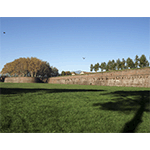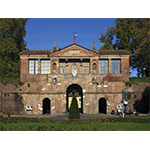The walls of Lucca
In its system of fortifications the city of Lucca shows the characteristic features of four stages, corresponding to four periods of construction. The first circle, of which few traces remain today, consists of the ancient Roman walls. In the 11th and 12th centuries the construction of the first medieval walls began, to be completed around the middle of the 13th century. Due to urban expansion, from the second half of the 14th to the first decades of the 15th century, the previous walls were extended.
The last expansion of the walls (4th circle) represents a striking example of military science in the 16th and 17th centuries. The construction of the walls was decreed the Republic of Lucca in 1504 to keep pace with progress in military technology and to guarantee better defence of the city, in fear of the Medici's expansionist policy. The work, begun in 1545 and completed around 1650, was carried out by important military architects such as Jacopo Seghizzi from Modena, Alessandro Resta from Milan, Ginese Bresciani from Firenzuola, the architects from Urbino, Baldassarre Lanci, Francesco Paciotto, Pietro Vagnarelli, the brothers Matteo and Muzio Oddi; the only architect from Lucca to participate in the work was Vincenzo Civitali.
The walls, which in some sections follow the course of the earlier medieval ones, are formed of eleven ramparts joined by curtains for a total length of over four kilometers. The ramparts, which ensured the protection of a section of wall or a gate, were positioned so that from each of them the two on either side of it could be seen. Constructed in different shapes and with different characteristics, they incorporated the turrets built between 1516 and 1522 at the corners of the medieval circle of walls. The rampart of San Frediano, the oldest, is the only one of rectangular shape. Those built later were bastions of the rounded orillion or square nose type, projecting far out from the curtains and thus more suited to the new defence techniques. On each rampart is a little building for the guards, called "casermetta" (still existing today). Inside the ramparts were big rooms for horses, soldiers and munitions. Both the ramparts and the curtains are faced in brickwork, with bricks manufactured in the kilns of the Lucca territory. On the outside of the wall is a steep escarpment bounded at the top by a stone cordon (torus), above which is a vertical parapet. On the inside, facing the city, the walls present a grassy escarpment consisting of a great quantity of earth amassed and packed down. A vast area devoid of trees or houses, traversed by ditches with water in them, called the "cut" (now drastically reduced), surrounded the entire circle of walls.
The three original gates in the Renaissance walls are the Porta San Pietro, the Porta Santa Maria, and the Porta San Donato, built in the second half of the 16th century. They were fortified gates, closed by drawbridges actuated by chains, by a rolling shutter, and by an iron-studded gate in the front and one in the back. Only in 1811 was a fourth gate opened, called the Elisa in honour of Elisa Bonaparte Baciocchi. This gate did not have the military features of the others, resembling more an arch of triumph. Two more gates, named the Vittorio Emanuele and the San Jacopo, were opened in 1911 and 1931.
The walls were equipped with an imposing military system. The artillery consisted of colubrines for firing at long range, cannons for firing metal cannonballs and stone-throwing cannons for launching stones. The cannons, built in one of the city's foundries, were made of bronze. The gunpowder was also produced in a saltpetre factory in the city. This enormous defensive apparatus was in reality never used in warfare. In 1799 the Austrians confiscated over 120 large-calibre cannons; since then the walls have lost all military value.
Growing on the circle of walls are centuries-old trees which, since the beginning, were planted to consolidate the enormous mass of earth. In the 19th century Duchess Maria Luisa of Bourbon commissioned the royal architect Lorenzo Nottolini to arrange the walls definitively as a public walkway. Still today, they are one of the favourite walking places in Lucca.
****************************
Texts by Graziano Magrini
English translation by Catherine Frost
Last update 21/ott/2008





